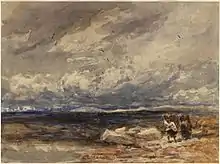Besom
A besom /ˈbiːzəm/ is a broom, a household implement used for sweeping. The term is now mostly reserved for a traditional broom constructed from a bundle of twigs tied to a stout pole. The twigs used could be broom (i.e. Genista, from which comes the modern name "broom" for the tool), heather or similar. The song "Buy Broom Buzzems" from Northern England refers to both types of twig. From the phrase broom besom the more common broom comes. In Scotland, besoms are still occasionally to be found at the edge of forests where they are stacked for use in early response to an outbreak of fire.



Description
As a result of its construction around a central pole, the brush of the besom is rounded instead of flat. The bristles can be made of many materials including, but not limited to straw, herbs, or twigs. Traditionally the handle is of hazel wood and the head is of birch twigs. Modern construction uses bindings of wire and string (instead of the traditional split withy) and the head is secured by a steel nail instead of a wooden dowel.
Besoms and the Flying ointment in Early Modern Witchcraft
.jpg.webp)

A number of different recipes for "flying ointments" have survived from the Early modern period,[1]some of the constituents of which not only have hallucinogenic properties but are fat-soluble and could have been absorbed transdermally. Certain researchers have speculated that the stereotypical image of the witch "flying" astride the broomstick of a besom may derive from traditions concerning the use of broomsticks or other staves by women to apply psychotropic ointments to their vaginal or anal mucosa.[2][3]The active ingredients in Flying ointments were primarily plants in the nightshade family Solanaceae, most commonly Atropa belladonna (deadly nightshade) and Hyoscyamus niger (henbane), belonging to the tropane alkaloid-rich tribe Hyoscyameae.[4] Other tropane-containing, nightshade ingredients included the famous Mandrake Mandragora officinarum, Scopolia carniolica and Datura stramonium, the Thornapple.[5] The alkaloids Atropine, Hyoscyamine and Scopolamine present in these Solanaceous plants are not only potent (and highly toxic) hallucinogens of the deliriant class, but are also fat-soluble and capable of being absorbed through unbroken human skin.[6][3] Another ingredient listed frequently in the various flying ointment recipes is the even more toxic Aconitum napellus, which has (among others) the English common name Wolfsbane (i.e. "slayer of wolves").[1]
In Wicca
A besom is a tool used in Wicca to cleanse and purify a space which will be used for ritual. A traditional Wiccan besom is an ash stave handle with bristles made from birch twigs. These twigs are tied on using thin pieces of willow wood. It is used to cleanse the ritual area before circle casting. While it does not usually touch the ground, it is used to "sweep out" the negative energies in a room, and is often held a few inches above the ground to do so. As a tool, the besom is usually thought of as masculine in nature due to its phallic shape and symbolism. However the besom's components are of both masculine and feminine orientation.[7] The handle, an ash stave, is masculine in nature while the birch used for the bristles is thought of as feminine in nature. The besom is thought to be involved with fairies.
The besom is an important part of Wiccan handfasting ceremonies in some traditions. The couple jump over the besom during the ceremony. Alternatively, the couple may jump over a small bonfire.
According to a note in the MacGregor Mathers translation of Abramelin, witches mounted upon broomsticks were said to leap around the fields while hallucinating with the aid of the flying ointment, in order to "teach the crops how high to grow", the vivid hallucinatory experience thus caused making them believe that they had flown great distances.[8] This interpretation is not supported (in its entirety) by most early modern sources, which generally describe the experience caused by flying ointments as one of prolonged death-like trance in which the ecstatic flight, wild dancing and carousal of the Sabbath were experienced in dream only, the body of the witch remaining immobile and thus incapable of any actual dancing, (- see, for example, the accounts in the Magia Naturalis of Giambattista della Porta).
References
- Hansen, Harold A. The Witch's Garden pub. Unity Press 1978 ISBN 978-0913300473
- Adams, Cecil (September 3, 1999). "What's the deal with witches and broomsticks?". Retrieved 3 March 2012.
- Harner, Michael J., Hallucinogens and Shamanism, pub. Oxford University Press 1973, reprinted U.S.A.1978 Chapter 8 : pps. 125–150.
- Hunziker, Armando T. The Genera of Solanaceae A.R.G. Gantner Verlag K.G., Ruggell, Liechtenstein 2001. ISBN 3-904144-77-4.
- Schultes, Richard Evans; Albert Hofmann (1979). Plants of the Gods: Origins of Hallucinogenic Use New York: McGraw-Hill. ISBN 0-07-056089-7.
- Sollmann, Torald, A Manual of Pharmacology and Its Applications to Therapeutics and Toxicology. 8th edition. Pub. W.B. Saunders, Philadelphia and London 1957.
- Gladheart, Friday. "Besom Briefs". PaganPath.com. Retrieved 19 February 2014.
- of Worms Abraham ben Simeon (2004). Mathers, S. L. MacGregor (ed.). The Book Of The Sacred Magic Of Abramelin The Mage (Illustrated ed.). Book Tree. ISBN 9781585092529.
External links
| Look up besom in Wiktionary, the free dictionary. |
- . Encyclopædia Britannica (11th ed.). 1911.
